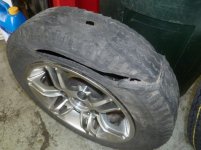Freddy
Active member
:bdh:If my spider was not in the shop I would ride on down.
:bdh:If my spider was not in the shop I would ride on down.
Ride-On has a filling volume listed for that tire. Not sure why they would verbally recommend against it. Anyway, I have not had any issues or excessive heat in 3,500 miles. I'll continue to run it.Good thread, read every post. It's good Lamont that you didn't let the circumstance get the best of you. I figure I have approx 7-8 miles on my trailer now. When I take the bike in for service is that when they should grease the bearings?
My dealership said they called Ride-On and were told that it is not recommended for that small of a tire.
:dontknow:
I do carry a spare.
This is good to know you were able to stop the bike and trailer safely!
Also since you replaced the one tire, is it necessary to replace the other side, since it looked like you had allot of wear on them ?

The race had to be cut off but there was no damage to the axle. Looks to me like the rear seal had let some moisture in and that's what helped speed the process of the bearing failure. I did look into new hub setups and I can get a triple lip seal hub with grease zerk for about 40 bucks each and that may be the route I take.View attachment 35092
You can see the "Flat Spot" on the tire. This is when the bearing physically seized and caused the blowout. Suffice it to say that avoiding any trailer damage is in-itself reason to celebrate!
Lamont, was there any axle damage (ie signs of over heating or scoring on the face of the race)?
The race had to be cut off but there was no damage to the axle. Looks to me like the rear seal had let some moisture in and that's what helped speed the process of the bearing failure. I did look into new hub setups and I can get a triple lip seal hub with grease zerk for about 40 bucks each and that may be the route I take.
http://www.northerntool.com/shop/tools/product_200466886_200466886
I check them at every tire change but there's no reason to change them if they are still good.I've debated whether to ask or not, but decided to go ahead and ask. I apologize in that it is a bit "off point", but similar. I think I recall Lamont with a video showing how to take the back wheel off. Additionally, I think I recall him saying that THAT was probably a good time to change the bearings on the rear wheel.
My question is IS there a rule of thumb for when one should change the bearings on the back wheel? Any input would be appreciated.
Chris
...My question is IS there a rule of thumb for when one should change the bearings on the back wheel? Any input would be appreciated.
Chris
The bearings on the real wheel are sealed so there is no grease to remove or there shouldn't be.
Mike's Personal Rule is, 1st completely clean and remove all of the old grease from the bearing assy. Then see how much radial and axial ply there is compared to a new bearing assy. (or you can actually measure this wear using a dial indicator). Finally, see what the manufacture recommends as "maximum wear" (ie play) for replacement of assy. You should get several thousands of miles before this is actually required, if preventative/scheduled maintenance is observed.
It is ALWAYS cheaper to replace a bearing assy versus having an accident caused by bearing failure.
Hope this helps.
The bearings on the real wheel are sealed so there is no grease to remove or there shouldn't be.
Hubometer http://www.accutrakdirect.com/servlet/the-2/stemco-datatrac-hubodometer-hubometer/Detail :thumbup:
Another free R & D for Can-Am.
